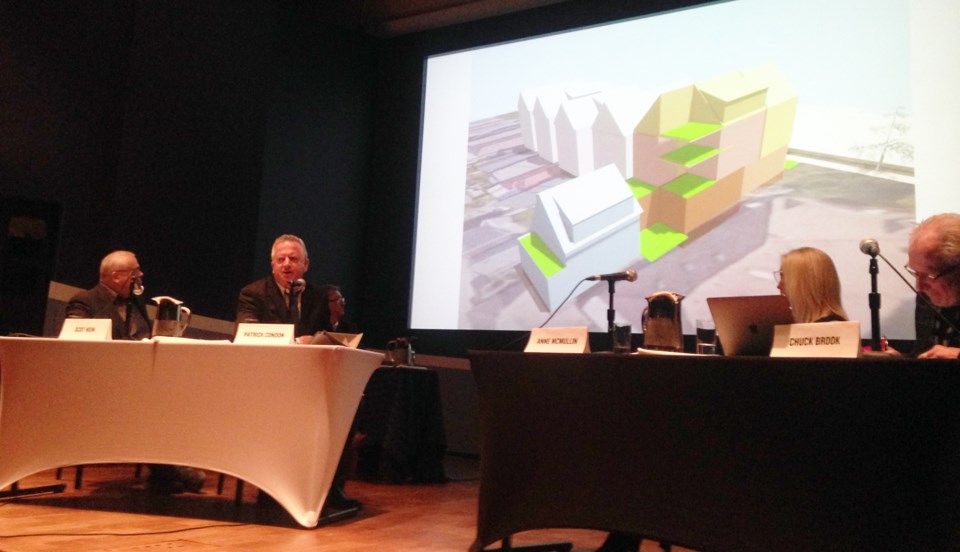A fascinating public debate took place Wednesday evening at UBC Robson Square, entitled “Smart Cities Debate #11: Building Missing Middle Housing Without Lot Assembly.”
This topic was set up as a resolution for debate, with two housing experts on the “Pro” side – that is, tasked with convincing the audience that sufficient “missing middle” housing for Vancouver’s needs can indeed be built without any land assembly – and two development industry leaders on the “Con” side, who believe land assembly is essential if enough housing is to be built.
Before any debate even took place, the 230-plus audience members voted on the resolution, with a 74 per cent initially siding with the no-land-assembly Pro side, and 26 per cent with the Con team. This result was fairly predictable, as it was doubtless a room full of local residents concerned about the land assembly and sky-high land prices currently seen in the city. However, the moderator explained the winning team would not be the one with the majority vote at the end, but the team who swayed more audience members to their side of the argument following the debate.
In the ensuing debate, one thing was clear on both sides of the stage – all were in favour of densification of some kind, in order to vastly increase the “missing middle” housing much-needed by Vancouverites, such as townhomes, rowhomes, duplexes and triplexes, smaller homes, and infill housing. Both sides also were in favour of widespread rezoning of Vancouver’s swathes of single-family neighbourhoods in order to achieve this. But the two sides presented very different ideas, and sometimes radical, about what this rezoning should allow.
UBC urban design chair Patrick Condon, who teamed up with his UBC colleague Scot Hein on the Pro side, offered the most radical solution. Taking a staunch anti-land-assembly position, Condon said that the way to densify single-family neighbourhoods was to rezone everywhere, increasing the allowable floor-space ratio to up to six units on each 33-foot lot. Condon’s solution was for owners to then develop their own properties to achieve this densification – presumably by each ploughing their life savings or home equity into this development project, going through all the permitting processes, moving out while their home is being lifted, moved forward, extended upwards and backwards and into the lane, and then eventually selling the new units at a profit for their trouble. He suggested that a row of, say, six detached houses could this way create 36 homes. That's more than enough supply when extrapolated across the city, even if it didn't happen on every lot, said Condon.
I had to wonder why the Con team, made up of Urban Development Institute CEO Anne McMullin and veteran developer Chuck Brook, didn’t rip Condon’s proposal to shreds (perhaps they’re more polite than me). To place the burden of Vancouver’s densification in the hands of single-family home owners – who likely have neither the expertise, nor the desire, nor the cash flow, nor the risk tolerance to take on the major redevelopment of their family home – seems preposterous. How many families would actually take on such a daunting project – even if there were money to be made at the end of it? It’s one thing if you choose to become an owner-developer as a career, but most people just want to enjoy their own homes and get on with their lives. I’m guessing only a handful would actually do it, which means there would not be anywhere near enough new housing, and the limited additional supply would remain expensive.
And what could happen, then, is building companies and developers would still come in and buy these properties at an inflated price, knowing that they can build six units out of one home – and most likely try to snap up the whole row so that they could develop them all at once. That’s no different to land assembly, except that you could only get 36 units out of that six-house row, rather than potentially 50 or 60, as you’d have to keep each building separate, and there would be no shared walls between the individual lots, or economies of scale. And there's no reason it would preserve a neighbourhood’s character any more than land assembly does.
The Con side, for their part, advocated radical densification and wholesale rezoning to allow for high-rises near transit hubs, mid-rises on major arterials, low-rises in the adjacent blocks, townhomes/rowhomes set a little further away from the arterials, and preserved “single-family” enclaves that still encourage infill homes and secondary/tertiary suites. Only this level of development, they said, would produce enough housing of all types to meet the city’s supply and affordability needs. They claimed that the reason land speculation is rife, and new townhome developments still very expensive, is that the available land to assemble is being drip-fed into the system in far-too-small increments, largely just on the Cambie Corridor and in the West End. (They also advocated having developments built by, you know, actual developers with the necessary expertise, resources and risk tolerance.)
Both sides agreed that City-imposed parking requirements and City permitting processes need a major overhaul, so those arguments seemed to cancel each other out.
The result of the final audience vote? The Pro team maintained their majority support, but it slipped to 69 per cent – giving the Con team the overall victory, as they had seen a five per cent swing in their favour. Since the Pro team didn’t seem to offer any workable solutions, I was not surprised the Con side managed to change a few minds.



